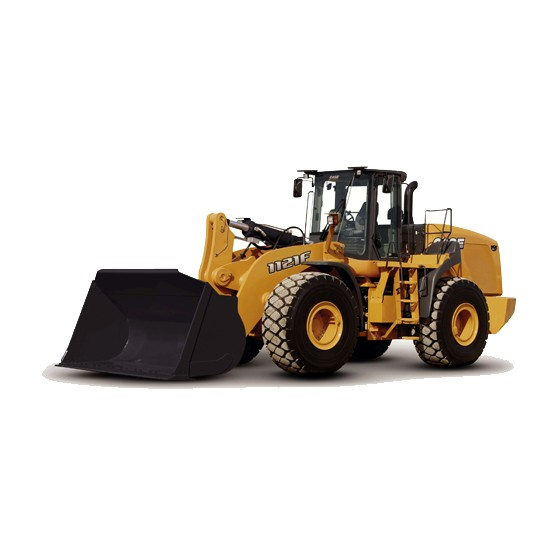
Subscribe to Our Youtube Channel
Summary of Contents for CASE CONSTRUCTION Stage IV 1021F
- Page 1 1021F 1121F Stage IV Wheel Loader SERVICE MANUAL Part number 47924630 English November 2015 © 2015 CNH Industrial Italia S.p.A. All Rights Reserved.
- Page 2 SERVICE MANUAL 1021F XR 1021F ZBAR 1121F XR 1121F ZBAR 47924630_EN 09/11/2015...
- Page 3 Contents INTRODUCTION Engine..................10 [10.001] Engine and crankcase ............. 10.1 [10.216] Fuel tanks .
- Page 4 [33.202] Hydraulic service brakes ............33.1 [33.110] Parking brake or parking lock .
- Page 5 Thanks very much for your reading, Want to get more information, Please click here, Then get the complete manual NOTE: If there is no response to click on the link above, please download the PDF document first, and then click on it. Have any questions please write to me: admin@servicemanualperfect.com...
- Page 6 [55.988] Selective Catalytic Reduction (SCR) electrical system ......55.4 [55.989] Exhaust Gas Recirculation (EGR) electrical system ....... 55.5 [55.DTC] FAULT CODES.
- Page 7 INTRODUCTION 47924630_EN 09/11/2015...
-
Page 8: Table Of Contents
Contents INTRODUCTION Safety rules ..................3 Personal safety . -
Page 9: Safety Rules
INTRODUCTION Safety rules Personal safety This is the safety alert symbol. It is used to alert you to potential personal injury hazards. Obey all safety messages that follow this symbol to avoid possible death or injury. Throughout this manual you will find the signal words DANGER, WARNING, and CAUTION followed by special in- structions. -
Page 10: Personal Safety
INTRODUCTION Personal safety Carefully read this Manual before proceeding with main- tenance, repairs, refuelling or other machine operations. Repairs have to be carried out only by authorized and in- structed staff; specific precautions have to be taken when grinding, welding or when using mallets or heavy ham- mers. - Page 11 INTRODUCTION Emergency Be prepared for emergencies. Always keep a fire extin- guisher and first aid kit readily available. Ensure that the fire extinguisher is serviced in accordance with the man- ufacturer’s instructions. SMIL12WEX0174AA Equipment Wear close fitting clothing and safety equipment appropri- ate for the job: •...
- Page 12 INTRODUCTION Pay attention to rotating components and do not allow anyone to approach these areas to avoid becoming en- tangled. Hands, clothing or tools getting caught in the fan blades or engine belts, can cause amputations, violent hemorrages and generate conditions of grave danger. For this reason avoid touching or approaching all rotating or moving parts.
- Page 13 INTRODUCTION When hydraulic oil has been swallowed, avoid vomiting, but consult a doctor or go to a hospital. If an accident occurs, see a doctor familiar with this type of injury immediately. Any fluid penetrating the skin must be removed within a few hours to avoid serious infections.
- Page 14 INTRODUCTION Hoses and tubes Always replace hoses and tubes if the cone end or the end connections on the hose are damaged. When installing a new hose, loosely connect each end and make sure the hose takes up the correct position be- fore tightening the connections.
- Page 15 INTRODUCTION Battery Batteries give off explosive gases. Never handle open flames and unshielded light sources near batteries. (No smoking is addressed in the next in- struction). To prevent any risk of explosion, observe the following instructions: • When disconnecting the battery cables, always discon- nect the negative (-) cable first.
- Page 16 INTRODUCTION Flammable liquids When handling flammable liquids: • Do not smoke. • Keep away from unshielded light sources and open flames. Fuels often have a low flash point and are readily ignited. Never attempt to extinguish burning liquids with water. Use: •...
- Page 17 INTRODUCTION Tires Before inflating the tires, always check the condition of rims and the outer condition of tires for the presence of dents, cuts, tears of reinforcement plies or other faults. Before inflating a tire, make sure that there are no nearby persons, then position yourself at tread side.
- Page 18 INTRODUCTION Waste disposal Improperly disposing of waste can threaten the environ- ment. Each country has its own Regulations on this subject. It is therefore advisable to prepare suitable containers to collect and store momentarily all solid and fluid materials that must not be scattered in the environment to avoid pollution.
-
Page 19: Basic Instructions - Important Notice Regarding Equipment Servicing
Some information could not be updated due to modifications of a technical or commercial type, or changes to the laws and regulations of different countries. In case of questions, refer to your CASE CONSTRUCTION Sales and Service Networks. 47924630_EN 09/11/2015... -
Page 20: Basic Instructions - How To Use The Maintenance Standard And Precautions
INTRODUCTION Basic instructions - How to use the maintenance standard and precautions Application WHEN THE MACHINE IS NEW Confirm that the performances are in accordance with standard specifications as compared to the performance stan- dards. AT SPECIFIC SELF INSPECTION (RULE BY COUNTRY) Use the data for the criterion, for the purpose of correction, adjustment and replacement. - Page 21 INTRODUCTION PARTS REQUIRING REGULAR REPLACEMENT Out of critical hoses that are necessary to secure safety, we designate Very Important Parts (V.I.P) and recommend that they should be replaced regularly. INSPECTION AND REPLACEMENT OF OILS AND GREASES In performing maintenance, it is necessary for the user to familiarize to handle the machine safely, cautions to be exercised and inspection/lubrication procedures.
-
Page 22: Basic Instructions - Precaution For Disassembly And Assembly
INTRODUCTION Basic instructions - Precaution for disassembly and assembly Preparations for disassembly • Thoroughly wash the machine before bringing it into the shop. Bringing a dirty machine into the shop may cause machine components to be contaminated during disassembling/assembling, resulting in damage to machine com- ponents, as well as decreased efficiency in service work.





Need help?
Do you have a question about the Stage IV 1021F and is the answer not in the manual?
Questions and answers